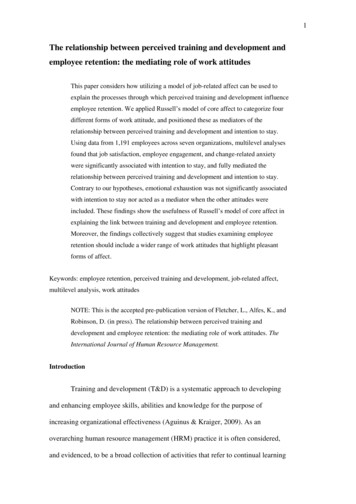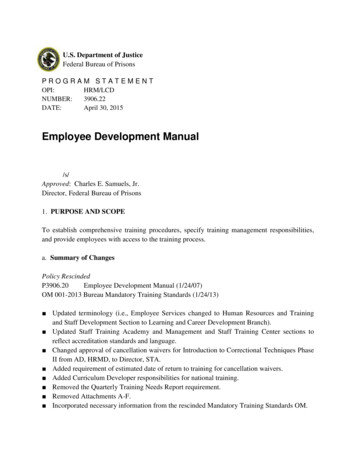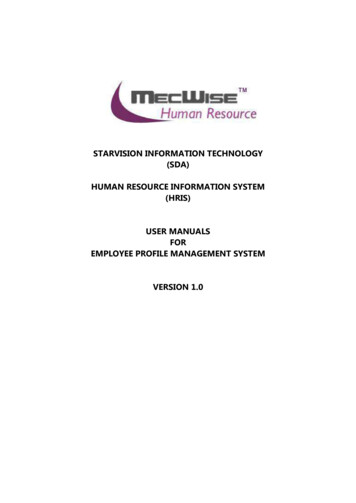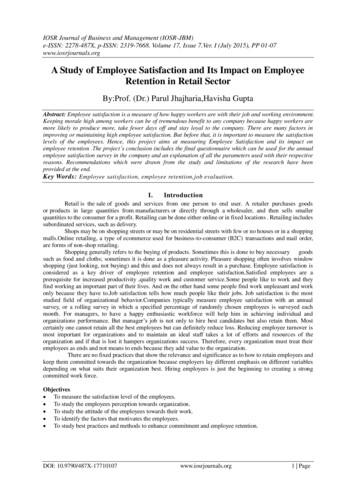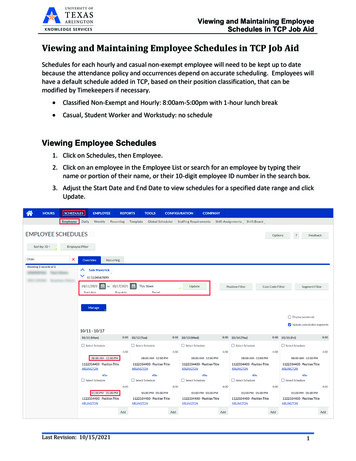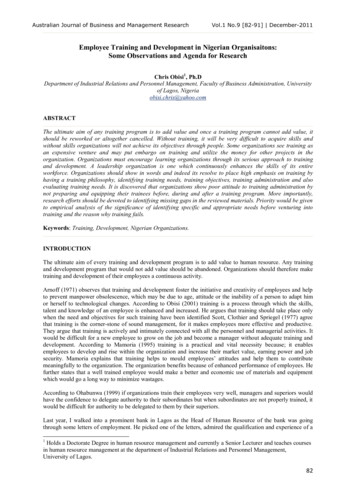
Transcription
Australian Journal of Business and Management ResearchVol.1 No.9 [82-91] December-2011Employee Training and Development in Nigerian Organisaitons:Some Observations and Agenda for ResearchChris Obisi1, Ph.DDepartment of Industrial Relations and Personnel Management, Faculty of Business Administration, Universityof Lagos, Nigeriaobisi.chris@yahoo.comABSTRACTThe ultimate aim of any training program is to add value and once a training program cannot add value, itshould be reworked or altogether cancelled. Without training, it will be very difficult to acquire skills andwithout skills organizations will not achieve its objectives through people. Some organizations see training asan expensive venture and may put embargo on training and utilize the money for other projects in theorganization. Organizations must encourage learning organizations through its serious approach to trainingand development. A leadership organization is one which continuously enhances the skills of its entireworkforce. Organizations should show in words and indeed its resolve to place high emphasis on training byhaving a training philosophy, identifying training needs, training objectives, training administration and alsoevaluating training needs. It is discovered that organizations show poor attitude to training administration bynot preparing and equipping their trainees before, during and after a training program. More importantly,research efforts should be devoted to identifying missing gaps in the reviewed materials. Priority would be givento empirical analysis of the significance of identifying specific and appropriate needs before venturing intotraining and the reason why training fails.Keywords: Training, Development, Nigerian Organizations.INTRODUCTIONThe ultimate aim of every training and development program is to add value to human resource. Any trainingand development program that would not add value should be abandoned. Organizations should therefore maketraining and development of their employees a continuous activity.Arnoff (1971) observes that training and development foster the initiative and creativity of employees and helpto prevent manpower obsolescence, which may be due to age, attitude or the inability of a person to adapt himor herself to technological changes. According to Obisi (2001) training is a process through which the skills,talent and knowledge of an employee is enhanced and increased. He argues that training should take place onlywhen the need and objectives for such training have been identified Scott, Clothier and Spriegel (1977) agreethat training is the corner-stone of sound management, for it makes employees more effective and productive.They argue that training is actively and intimately connected with all the personnel and managerial activities. Itwould be difficult for a new employee to grow on the job and become a manager without adequate training anddevelopment. According to Mamoria (1995) training is a practical and vital necessity because; it enablesemployees to develop and rise within the organization and increase their market value, earning power and jobsecurity. Mamoria explains that training helps to mould employees’ attitudes and help them to contributemeaningfully to the organization. The organization benefits because of enhanced performance of employees. Hefurther states that a well trained employee would make a better and economic use of materials and equipmentwhich would go a long way to minimize wastages.According to Ohabunwa (1999) if organizations train their employees very well, managers and superiors wouldhave the confidence to delegate authority to their subordinates but when subordinates are not properly trained, itwould be difficult for authority to be delegated to them by their superiors.Last year, I walked into a prominent bank in Lagos as the Head of Human Resource of the bank was goingthrough some letters of employment. He picked one of the letters, admired the qualification and experience of a1Holds a Doctorate Degree in human resource management and currently a Senior Lecturer and teaches coursesin human resource management at the department of Industrial Relations and Personnel Management,University of Lagos.82
Australian Journal of Business and Management ResearchVol.1 No.9 [82-91] December-2011particular candidate and suddenly threw the applicant's letter into the trash basket. He said the candidate wasover qualified, our organization cannot bend this candidate, he added. But I believe that with training, thecandidate could become flexible, dynamic and adaptive to the organizations needs and environment.TYPES OF TRAININGThere are two major types of training, on-the -job training and off- the -job training as identified by Alo (1999):On-the-job training, is normally handled by colleagues, supervisors, managers, mentors' to help employeesadjust to their work and to equip them with appropriate job related skills Armstrong (1995) argues that on-thejob training may consist of teaching or coaching by more experienced people or trainers at the desk or at thebench. It may also consist of individual or group assignment and projects and the use of team leaders andmanagers.According to Armstrong, on-the-job training is the only way to develop and practice the specific managerial,team leading, technical, selling, manual, and administrative skills needed by the organization and it has theadvantages of actuality and immediacy as the individual works, learns and develops expertise at the same time.Disadvantages of on-the-job training according to Armstrong are that the effectiveness of the learning isstrongly influenced by the quality of the guidance and coaching provided on the job. Many managers and teamleaders are unskilled at training and disinclined to carry it out or to encourage it. Furthermore, relying on fellowemployees in “sit by me” training has obvious disadvantages as instruction may be inadequate and the trainingmay perpetuate bad habits. Again, the learner may be distracted by the same environment and find it difficult toacquire basic skills quickly.To resolve these disadvantages, train the trainers programme should be regularly embarked upon to sharpen theskills of supervisors and in-house trainers.Off-the-job TrainingAccording to Ejiogu (2000) off-the-job training would include lecture, vestibule training, role playing, casestudy, discussion and simulation Armstrong (1995) listed group exercises, team building, distance learning,outdoor and workshops as part of off-the-job training. He further explains that off-the-job training may beprovided by members of the training department, external education and training establishments, or trainingproviders-training consultants or guest speakers. He encourages line managers to be closely involved to bringreality into the classroom, to ease the transfer of learning, and to make sure that those involved in off-the-jobtraining are carefully selected, briefed and monitored so as to ensure that they make the right contribution.Understanding Training and DevelopmentAccording to Obisi (1996) the concepts, of training and development are used interchangeably. However, it canbe differentiated from the other. Training is for specific job purpose while development goes beyond specificsdevelopment covers not only those activities which improve job performance, but also those which bring aboutgrowth of personality. In training, you using one stone to kill one bird while in development you use one stoneto kill two birds Mamoria, (1995).Steinmetz, Lawrence (1996) notes that training is a short-term process, utilizing a systematic and organizedprocedure by which non-managerial personnel learn technical knowledge and skill for a definite purpose.Development on the other hand is a long term educational process utilizing a systematic and organizedprocedure by which managerial personnel learn conceptual and theoretical knowledge for general purpose.Cambell, (1971) states that training refers only to instruction in technical and mechanical operations whiledevelopment refers to philosophical and theoretical educational concept. Training is designed for non- managerswhile development involves managerial personnel. Training courses are typically designed for a short term,stated purpose, such as the operation of some piece (s) of machinery while development involves a broadereducation for long-term purpose. Training is for short-term while development is for long-term. Training is forspecific job related purpose while development is for general purpose.Vital issues in Training and DevelopmentAccording to Armstrong (1995) the following issues are relevant to Training and development effectiveness.83
Australian Journal of Business and Management Research Vol.1 No.9 [82-91] December-2011Organization training and development philosophyStrategic focus in TrainingRelevance of trainingTraining processIdentifying Training Needs and Training Needs analysisIdentifying Training ObjectivesEvaluation of TrainingOrganization Training and Development PhilosophyPhilosophy is the starting point to wisdom. Any organization that does not have a training philosophy is boundto fail for it invariably means that it does not have a serious approach for training. It may also mean that theorganization pays lip service to training. If an organization does not have a training philosophy, it means that theorganization does not believe in training. If an organization does not believe in training, it also means that thereis no deliberate effort on the part of the organization to encourage training. For example, Some Nigerianorganizations may stop temporarily their training activities and divert money meant for training, to otheractivities. But if the organization has a strong training philosophy it would attach great importance to training.Strategic Focus in TrainingTraining activities in an organization should be a continuous process and not a once and for all activity. It is anon going process for new, old, transferred and promoted employees. According to Armstrong (1995) trainingstrategy takes a long- term view of what skills, knowledge and levels of competence employees of theorganization need. Training should be an integral part of the management process which in turn requiremanagers to review regularly with their teams and the individuals reporting to them, performance in relation toagreed objectives.Relevance of TrainingRelevance of training is a very important issue that organizations should look critically at if they really want toimprove the effectiveness of their employees. Any training program that is not relevant should not beundertaken. Training should be designed to solve problems and to fill gaps in employee performance. Trainingshould make things happen and bring about changes that would enhance organization’s effectiveness. It is notproper for an organization to embark on any training program which is not relevant to it and its people.Armstrong (1995) agrees that for any training program to be relevant, it must satisfy identified and appropriateneeds.Planned TrainingAccording to Kenney and Reid (1995) planned training is the deliberate intervention aimed at achieving thelearning necessary for improved job performance. Planned training according to Kenney and Reid consists ofthe following steps: Identify and define training needs Define the learning required in terms of what skills and knowledge have to be learnt and what attitudesneed to be changed. Define the objectives of the training Plan training programs to meet the needs and objectives by using right combination for trainingtechniques and locations. Decide who provides the training Evaluate training. Amend and extend training as necessary.84
Australian Journal of Business and Management ResearchVol.1 No.9 [82-91] December-2011Identify TrainingNeedsFig. 3Defines LearningRequirementsPlan ersImplementTrainingEvaluateTrainingThe Process of Planned TrainingSource: Armstrong Michael (1995) A Hand Book on Personnel Management Kogan Page London.The inability of organizations to identify training needs is one of the major tragedies in organizations trainingpractice. Employee performance appraisal outcome should reveal strengths and weakness. The weaknessrevealed should form training needs. Whenever there is a gap or vacuum between what employee is doing andwhat he should do, there is a training need.Armstrong (1995) presents a clearer understanding of what is meant by training needs. He writes that the gapbetween what people know and can do and what people should know and be able to do is called training need.Therefore when an organization observes that there is a gap between what is happening and what shouldhappen, there is a training need.Analysis of Training need: There are four major ways of analyzing training needs. Analysis of jobs Performance appraisal Conducting training surveys Business and human resource analysisArmstrong (1995) gives a diagrammatical analysis of training needs. Training should be analyzed first for theorganization as a whole-first for corporate needs, second, for department, teams, functions or occupations withinthe organization-group needs, and third, for individual employees-individual needs.85
Australian Journal of Business and Management ResearchCorporateVol.1 No.9 [82-91] December-2011GroupIndividualAnalysis ofAnalysis wsanalysisPlanresourcePlansTraining Need analysis-Areas and MethodsSource: Armstrong Michael (1995) A handbook of personnel Management practice Kogan page London.Training ObjectivesObjectives of training are what employees would achieve and gain after undergoing the training program. Thebenefits of a training program refer to the objectives. Before employees embark on any training program, it isassumed that there are handicaps. If the handicaps are overcome after undergoing the training program it meansthat objectives have been achieved. Objectives mean what we can learn and do after a training program. Someorganizations send their employees on a training program without identifying objectives and without knowingwhat the trainees would achieve by the time they come back from the training program, they will be able toachieve certain things. For example, employees were not able to conduct bank reconciliation statement or werenot able to operate windows '98 and windows 2000. If they are able to do so at the end of a training program,one could say that the objectives have been realized.Training Proposal and Planned of TrainingEmployee training is not cheap. It is a costly affair as care should be taken in drafting training proposal. Thefollowing steps should be taken into consideration, while drafting a training proposal Identifying Training needs Developing a theme for the training program. Introducing the theme. Objectives of the training program has to be identified Content of the training Benefits to participants Benefits to the organization Resource persons Duration Cost Training method Venue Time86
Australian Journal of Business and Management Research Vol.1 No.9 [82-91] December-2011Target groupFeedback, Monitoring and follow-upTraining FacultyTraining faculty consists of those who are in charge of training the participants. According to Fajana (1997)training faculty should be made up of competent instructors. The instructor should be competent in his or herareas of specialization and should have the personality to convey competence and ability. Atiomo (2000)explains that the training faculty should be aware in details of planned changes in policy, structure or processwithin the organization, as regards training. They should work more from within than from outside and beconscious of the need for continuity of training plans and activities. The growing complexity of industry and itsproblems makes increasing demands on the training faculty members to improve the quality of the workforce atall levels.The training faculty should also have credibility with the trainees and should be able to use the chosen learningmethods to meet learning objectives and they should be available whenever they are needed.In the final analysis training faculty members should not only come from within the organization but externalconsultants should also be encouraged to be faculty members so that they can bring independence, experience,expertise and as Armstrong (1995) says that the external faculty members can bring a useful 'extra pair of hands'to the training activities.Information and LogisticsFor training programs to be effective, information should be readily available to the trainees. Extensivediscussion with the trainees would go a long way to prepare them on various issues like reasons for the trainingand the benefit of the training to the trainees and the organization.The inability to provide timely information and poor logistics can ruin training programs. At times you hearparticipants in a training program coming late or even not coming on the first day and this may not beunconnected with lack of logistics. Good transport, accommodation, and releasing money for the trainees ontime. In some cases, the final approval for the training may be done on the day the training program is starting.The location for the training should be conducive to help the participants relax and concentrate on the trainingactivities.Training Aids and Support MaterialsAccording to Mamoria (1995) training materials have to be prepared with care and distributed among thetrainees so that they may come well-prepared to a session and are able to understand the operations anddemonstrations quickly and correctly. Mamoria argues that the following are the variety of tools and equipmentutilized to impart effective training. Lectures Role playing Case studies Use of pamphlets, charts, brochures, booklets, handbook etc. Graphics, pictures, books, slides, movie projector, film strips, tape records. Reading room and libraries Teaching machines.Evaluation of TrainingThe process of evaluation enables us to know whether a training program has been worthwhile or a waste oftime. If the training has not been worthwhile, then it can be amended.Employees come back from a training program and it is business as usual. This kind of approach may rendertraining program impotent. Hamblin (1974) writes that evaluation of training program is any attempt to obtaininformation (feedback) on the effects of a training program, and to assess the value of the training in the light ofthe information obtained.87
Australian Journal of Business and Management ResearchVol.1 No.9 [82-91] December-2011Evaluation of training program would enable organization find out whether or not the training has achieved itspurpose, and objectives. One of the ways of evaluating training programs is by getting reactions from thetrainees, by asking those who attended the training to write a report or by designing a comprehensivequestionnaire which should be distributed to those who attended the training programme. Information obtainedfrom the questionnaire should be analyzed for success or failure of the training. Training could also be evaluatedthrough job performance.This can be done by measuring the extent to which trainees have applied what they have learnt from the trainingon their job. Evaluation of training can also be done by measuring the impact of a training program on workingof the unit or department where the trainees come from. The truth is that every training program should haveeffect not only on the employees who went for the training but the department or the unit where the traineescome from Armstrong, (1995). Finally evaluation of training program can also be done by looking at the impactof the training program on the entire organization.The assumption is that the organization pays for employee training program and the organization should feel theimpact or the effect of the training program. Therefore training program should be evaluated starting from theeffects of the training on the employees who participated in the training program to the department or unit theywork with and the ultimate effect on the organization.Responsibility for TrainingEverybody in the organization is responsible for training. It is not true that it is only management that isresponsible for training. Employees should take their destinies in their own hands and train and developthemselves in their organizations but many are not ready to do that, truly speaking, four major groups should beresponsible for training in an organization. These groups should include the top management who sees to theframing of training policy, the human resource department that organizes designs and audits training programs,the supervisor and officers who carry out the training programs and lastly the employees that help in providingfeedback.Creating a Desire for TrainingOrganizations should create conducive environment for training to flourish. Employees at all levels can bepersuaded to have interest in training. Robert and Benn (1969) explain that trainees will respond to trainingprograms involving changed behavior if they believe that the resulting modification in the behavior is in theirown interest, that they will receive personal benefits as a result of their new behavior. Secondly, trainees willchange their behavior if they became aware of better ways of performing (more productive or otherwise moresatisfactory ways) and gain experience in the new pattern of behavior so that it becomes their normal manner ofoperation. Organizations should create a learning environment which will serve as a motivation for employees.Why Training FailOrganizations training practices can fail for many reasons. Burak, Elmer and Smith Robert (1977) give thefollowing reasons: The benefits of training are not clear to the top management The top management hardly rewards supervisors for carrying out effective training. The top management rarely plans and budgets systematically for training. The middle management, without proper incentives from top management, does not account fortraining in production organization Training external to the employing unit sometimes teaches techniques on method contrary to practiceof the participants scheduling. Trainers provide limited counseling and consulting services to the rest of the organization.Trainers and TrainingDespite elegant and elaborate training programs, objectives of training programs are at times not achieved. Theinability of training programs to achieve their objective is called training snap. The following reasons aresuggested as the cause of training snap as argued by Armstrong (1995). Trainees who attended training program may not have learnt anything and they come home empty88
Australian Journal of Business and Management Research Vol.1 No.9 [82-91] December-2011handed.Trainees who participated in the training program may learn something from the training they attendedbut they may not be allowed to apply it in their organization due to personal influences and awkwardattitudes pervading their work environment.Training CycleAccording to Management Services Commission (1981) Training Cycle involves identifying deficiencies,designing inputs, out puts and identifying learning strategies which should be evaluated to produce feedbackwhich can be used to improve subsequent training. According to Imanyi (2002) systematic training cycle wouldinclude the following: identifying training needs, planning the training, carrying out the training and evaluatingthe training to know whether the training program is worthwhile.Training CycleIdentify TrainingNeedSource: Imanyi G.U (2002) Participants Training Manual C.M.D Management Trainers DevelopmentEvaluatePlan TrainingThe Training Cycle (1)Identification of the training needsCarry out Training(5)Evaluation i.e. feedback(2)Design the training programme(4)The transfer of learning i.e.Implementation of what is learnt(3)The acquisition of the skills,knowledge and/or the correct attitudeSource: Atiomo (2000) Practical Human Resource Management Malthouse Press Ltd Lagos.Target GroupEmployees with varying skills require training. It is important to identify the target group that the training ismeant for, According to Mamoria (1995). Target group in a training program could be unskilled employees,89
Australian Journal of Business and Management ResearchVol.1 No.9 [82-91] December-2011semi skilled employees, and skilled employees. Other target group could also be typists, stenographers,accounts, clerks and those who handle computer. They all need training in their particular fields.Instructors or resource persons should know in advance the target group for the training in order to avoidirrelevant discussion and give them enough time to prepare and discuss to the point.Training MethodsAccording to Armstrong (1995) there are a wide variety of training techniques that can be used. These can bedivided into:On-the-job techniques, which are practiced on a day-to-day basis or as part of a specially tailored trainingprograms. These include job rotation, planned experience and mentoring.Off-the-job techniques, which are used in formal training course away from the place of work. These includelectures, talks, simulation, case study, role playing, workshops etc.Fajana (1997) argues that the important thing in choosing training methods is to recognize the nature of thetraining that will take place and facilitate it. According to him, the biggest problem in training methods lies inthe failure to realize the distinction between learning theory and principles, and "how to" in practice.Training AdministrationTraining administration according to Fashola (2002) is the series of activities undertaken by the coordinatorbefore, during and after a programme to ensure its success. Training administration is the deploying of allnecessary inputs to achieve the objectives of a training programme. Fashola argues that the following issuesshould be considered in training administrationMake your audience or participants feel at home.Brief resource persons properlyProvide decent locationEnd the training on a cheerful note.CONCLUDING REMARKSTraining and development is the tonic employees need to enhance their performance and potentials that will inturn enhance organization effectiveness.Nigerian organizations should face realities, serious approach to training and development requires carefulsystematic and planned training and development activities. Nigerian organizations should invest more intraining and development as money invested in the employees is like money kept in a safe deposit, whichappreciates in value over time.Personal and awkward influences are affecting employee-training efforts. Laisez-Faire approach to employeetraining is retrogressive. A situation where organizations believe that training and development is an act of faith,that employees should find their way is fraught with dangerous consequences. Some organizations are acceptingtraining programs from their friends and relatives which are not based on the need of their organization. On theother hand, some employees do not show seriousness whenever they are sent on a training program. They comelate, in some cases, on a five day training program; they would show up only on the last day.Training should therefore be based on the need of the organization. It must benefit the employee in terms ofperformance and knowledge which will in turn affect the organization. As it is, some of the micro and macroinstitutions designed to train and equip employees with the necessary skills and knowledge are not doing verywell in terms of number of people these institutions train. We recommend strongly that all Training andDevelopment Institutions in Nigeria like company training institutions, Institute of Personnel Management ofNigeria, Industrial Training Fund, Centre for Management Development. Administrative Staff College ofNigeria, Financial Institutions Training Center etc. should be reinvigorated to bring about effective training anddevelopment capable of sustaining organization to wining a competitive advantage.Need for Further ResearchBased on some observations mentioned in this text, there is a need to conduct a survey on the major issues90
Australian Journal of Business and Management ResearchVol.1 No.9 [82-91] December-2011raised in this paper like an analysis of the significance of identifying training needs, objectives etc. and thereasons why training fail.REFERENCES1. Alo Oladimeji (1999) Human Resource Management in Nigeria, Business science Books, Lagos.2. Armstrong Michael (1995) A handbook of personnel Management Practices, Kogan Page LimitedLondon.3. Arnoff, J. (1971) Achievement Motivations Training and Executives advancement, Journal of AppliedScience New York Vol. 7(1)4. Atiomo, A.C. (2000) Human Resource Management, Malthouse Management science Book, Lagos.5. Burak, Elmar and Smith, Robert (1977) Personnel Management A human resources systems approach,West publishing Company, New York.6. Cambell, J. (1971) Personnel Training and Development, Annual Review of Psychology.7. Ejiogu Aloy (2000), Human Resource Management towards Greater Productivity, GenerationPress Ltd Lagos.8. Fajana Sola (1997) Human Resources Management Labofin and Company Lagos.9. Fashola Aderonke (2002) Management Trainers Development, Participants Training Manual C.M.D.Lagos10. Hamblin A. C. (1974) Evaluation and Control of Training, McGraw-Hill Maidenhead11. Imanyi, G. U (2002) Participants Training manual C.M.D Management Trainers Development: Lagos.12. Journal of Applied Science New York Vol. 7 (1)13. Kenneth D. B. (1995) personnel Management, Himalaya Publishing House New Delhi ManpowerServices Commission (1981) Glossary of Traini
Keywords: Training, Development, Nigerian Organizations. INTRODUCTION The ultimate aim of every training and development program is to add value to human resource. Any training and development program that would not add value should be abandoned. Organizations should therefore make training and devel




